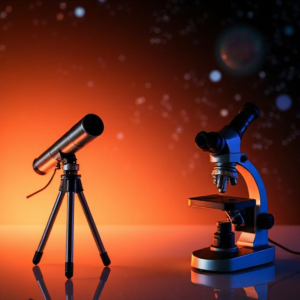What Are Optical Instruments?
Optical instruments are tools that help us see things more clearly or more closely than we can with just our eyes. They work using lenses or mirrors to focus light in special ways.
The three most common types of optical instruments are telescopes, microscopes, and spectrometers. Each of these has a unique purpose and helps us observe the world in different ways.

1. Telescopes
A telescope is an optical instrument that helps us see distant objects, like stars, planets, and galaxies. It’s like a giant “zoom lens” for the sky!
How It Works:
- Telescopes collect light from distant objects and focus it so that we can see them more clearly.
- The two main parts of a telescope are:
- Objective lens (or mirror): This gathers light from the object you’re trying to see. The bigger the lens or mirror, the more light it can gather and the clearer the image.
- Eyepiece lens: This helps magnify the image and lets you see the details.
Types of Telescopes:
- Refracting telescopes use lenses to bend light.
- Reflecting telescopes use mirrors to collect and focus light.
Example:
- When you look through a telescope at the moon, the telescope gathers lots of light, focuses it, and makes the moon look much bigger and clearer than it does with your naked eye.
2. Microscopes
A microscope is an optical instrument used to see tiny objects that are too small for the naked eye, like bacteria, cells, and the structures of tiny objects.
How It Works:
- A microscope uses lenses to magnify objects so that we can see them in more detail.
- The basic parts of a microscope include:
- Objective lens: This is the main lens that magnifies the image of the small object.
- Eyepiece: This is where you look through to see the magnified image.
- Stage: The platform where the object (like a slide) is placed.
- Light source: This shines light through the object to make it easier to see.
Types of Microscopes:
- Light microscopes: These use visible light and lenses to magnify objects. They can magnify up to about 1,000 times.
- Electron microscopes: These use electron beams instead of light and can magnify objects up to 1 million times! This allows scientists to see things like viruses or individual atoms.
Example:
- When scientists want to study a cell, they place a thin slice of it under a microscope. The microscope magnifies the image so the details of the cell’s structure become visible.
3. Spectrometers
A spectrometer is an optical instrument used to measure the spectrum (range of light) emitted or absorbed by objects. It helps us study the chemical composition and properties of substances.
How It Works:
- A spectrometer works by splitting light into its different colors (a spectrum) and then analyzing how much light of each color is present.
- It works with prisms or diffraction gratings to split light. Then, a detector measures how much light is in each part of the spectrum.
Why It’s Useful:
- Spectrometers help scientists understand the composition of distant stars, chemicals, or even gases in the atmosphere.
- Different elements or molecules absorb or emit specific colors of light. By looking at these colors, scientists can figure out what materials are present.
Types of Spectrometers:
- Mass spectrometers: Measure the mass-to-charge ratio of ions.
- Optical spectrometers: Measure the light spectrum of an object.
Example:
- When scientists look at the light from a star, they use a spectrometer to break the light into different colors. By studying the pattern of colors, they can tell what elements (like hydrogen or oxygen) are in that star, how hot it is, and even how far away it is.
Summary :
- Telescopes: Used to see distant objects (like stars and planets). They collect and focus light to make distant objects look bigger and clearer.
- Microscopes: Used to see very tiny objects (like cells or bacteria). They magnify small objects so we can see details that are invisible to the naked eye.
- Spectrometers: Used to study the light emitted or absorbed by objects. They help us understand the chemical composition of materials, whether it’s stars, gases, or even chemicals in a lab.











